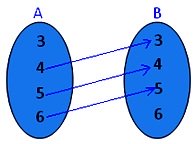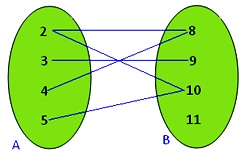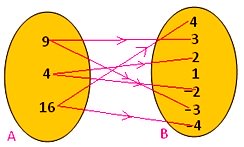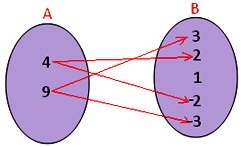Subscribe to our ▶️ YouTube channel 🔴 for the latest videos, updates, and tips.
Domain and Range of a Relation
In domain and range of a relation, if R be a relation from set A to set B, then
• The set of all first components of the ordered pairs belonging to R is called the domain of R.
Thus, Dom(R) = {a ∈ A: (a, b) ∈ R for some b ∈ B}.
• The set of all second components of the ordered pairs belonging to R is called the range of R.
Thus, range of R = {b ∈ B: (a, b) ∈R for some a ∈ A}.
Therefore, Domain (R) = {a : (a, b) ∈ R} and Range (R) = {b : (a, b) ∈ R}
Note:
The domain of a relation from A to B is a subset of A.
The range of a relation from A to B is a subset of B.
For Example:
If A = {2, 4, 6, 8) B = {5, 7, 1, 9}.
Let R be the relation ‘is less than’ from A to B. Find Domain (R) and Range (R).
Solution:
Under this relation (R), we have
R = {(4, 5); (4, 7); (4, 9); (6, 7); (6, 9), (8, 9) (2, 5) (2, 7) (2, 9)}
Therefore, Domain (R) = {2, 4, 6, 8} and Range (R) = {1, 5, 7, 9}
Solved examples on domain and range of a relation:
1. In the given ordered pair (4, 6); (8, 4); (4, 4); (9, 11); (6, 3); (3, 0); (2, 3) find the following relations.
Also, find the domain and range.
(a) Is two less than
(b) Is less than
(c) Is greater than
(d) Is equal to
Solution:
(a) R₁ is the set of all ordered pairs whose 1ˢᵗ component is two less than the 2ⁿᵈ component.
Therefore, R₁ = {(4, 6); (9, 11)}
Also, Domain (R₁) = Set of all first components of R₁ = {4, 9} and Range (R₂) = Set of all second components of R₂ = {6, 11}
(b) R₂ is the set of all ordered pairs whose 1ˢᵗ component is less than the second component.
Therefore, R₂ = {(4, 6); (9, 11); (2, 3)}.
Also, Domain (R₂) = {4, 9, 2} and Range (R₂) = {6, 11, 3}
(c) R₃ is the set of all ordered pairs whose 1ˢᵗ component is greater than the second component.
Therefore, R₃ = {(8, 4); (6, 3); (3, 0)}
Also, Domain (R₃) = {8, 6, 3} and Range (R₃) = {4, 3, 0}
(d) R₄ is the set of all ordered pairs whose 1ˢᵗ component is equal to the second component.
Therefore, R₄ = {(3, 3)}
Also, Domain (R) = {3} and Range (R) = {3}
2. Let A = {2, 3, 4, 5} and B = {8, 9, 10, 11}.
Let R be the relation ‘is factor of’ from A to B.
(a) Write R in the roster form. Also, find Domain and Range of R.
(b) Draw an arrow diagram to represent the relation.
Solution:
(a) Clearly, R consists of elements (a, b) where a is a factor of b.
Therefore, Relation (R) in the roster form is R = {(2, 8); (2, 10); (3, 9); (4, 8), (5, 10)}
Therefore, Domain (R) = Set of all first components of R = {2, 3, 4, 5} and Range (R) = Set of all second components of R = {8, 10, 9}
(b) The arrow diagram representing R is as follows:
3. The arrow diagram shows the relation (R) from set A to set B. Write this relation in the roster form.
Solution:
Clearly, R consists of elements (a, b), such that ‘a’ is square of ‘b’
i.e., a = b².
So, in roster form R = {(9, 3); (9, -3); (4, 2); (4, -2); (16, 4); (16, -4)}
Worked-out problems on domain and range of a relation:
4. Let A = {1, 2, 3, 4, 5} and B = {p, q, r, s}. Let R be a relation from A in B defined by
R = {1, p}, (1, r), (3, p), (4, q), (5, s), (3, p)}
Find domain and range of R.
Solution:
Given R = {(1, p), (1, r), (4, q), (5, s)}
Domain of R = set of first components of all elements of R = {1, 3, 4, 5}
Range of R = set of second components of all elements of R = {p, r, q, s}
5. Determine the domain and range of the relation R defined by
R = {x + 2, x + 3} : x ∈ {0, 1, 2, 3, 4, 5}
Solution:
Since, x = {0, 1, 2, 3, 4, 5}
Therefore,
x = 0 ⇒ x + 2 = 0 + 2 = 2 and x + 3 = 0 + 3 = 3
x = 1 ⇒ x + 2 = 1 + 2 = 3 and x + 3 = 1 + 3 = 4
x = 2 ⇒ x + 2 = 2 + 2 = 4 and x + 3 = 2 + 3 = 5
x = 3 ⇒ x + 2 = 3 + 2 = 5 and x + 3 = 3 + 3 = 6
x = 4 ⇒ x + 2 = 4 + 2 = 6 and x + 3 = 4 + 3 = 7
x = 5 ⇒ x + 2 = 5 + 2 = 7 and x + 3 = 5 + 3 = 8
Hence, R = {(2, 3), (3, 4), (4, 5), (5, 6), (6, 7), (7, 8)}
Therefore, Domain of R = {a : (a, b) ∈R} = Set of first components of all ordered pair belonging to R.
Therefore, Domain of R = {2, 3, 4, 5, 6, 7}
Range of R = {b : (a, b) ∈ R} = Set of second components of all ordered pairs belonging to R.
Therefore, Range of R = {3, 4, 5, 6, 7, 8}
6. Let A = {3, 4, 5, 6, 7, 8}. Define a relation R from A to A by
R = {(x, y) : y = x - 1}.
• Depict this relation using an arrow diagram.
• Write down the domain and range of R.

Solution:
By definition of relation
R = {(4, 3) (5, 4) (6, 5)}
The corresponding arrow diagram is shown.
We can see that domain = {4, 5, 6} and Range = {3, 4, 5}
7. The adjoining figure shows a relation between the sets A and B.
Write this relation in
• Set builder form
• Roster form
• Find the domain and range
Solution:
We observe that the relation R is 'a’ is the square of ‘b'.
In set builder form R = {(a, b) : a is the square of b, a ∈ A, b ∈ B}
In roster form R = {(4, 2) (4, -2)(9, 3) (9, -3)}
Therefore, Domain of R = {4, 9}
Range of R = {2, -2, 3, -3}
Note: The element 1 is not related to any element in set A.
● Relations and Mapping
Domain and Range of a Relation
Domain Co-domain and Range of Function
● Relations and Mapping - Worksheets
Worksheet on Functions or Mapping
7th Grade Math Problems
8th Grade Math Practice
From Domain and Range of a Relation to HOME PAGE
Didn't find what you were looking for? Or want to know more information about Math Only Math. Use this Google Search to find what you need.





New! Comments
Have your say about what you just read! Leave me a comment in the box below. Ask a Question or Answer a Question.